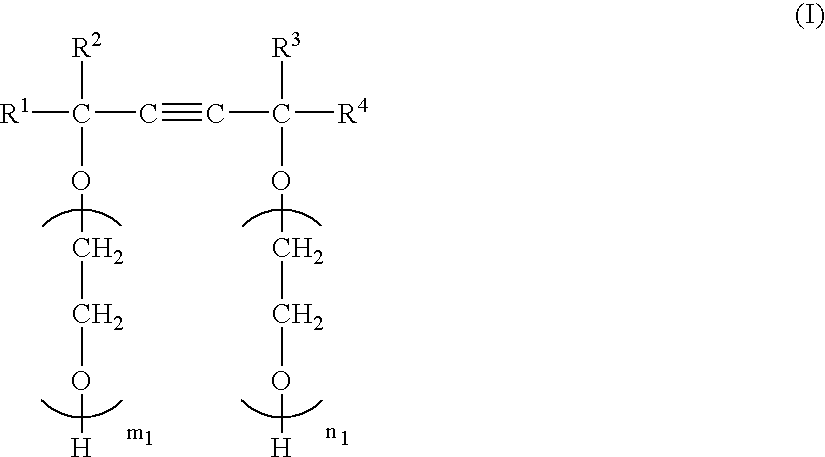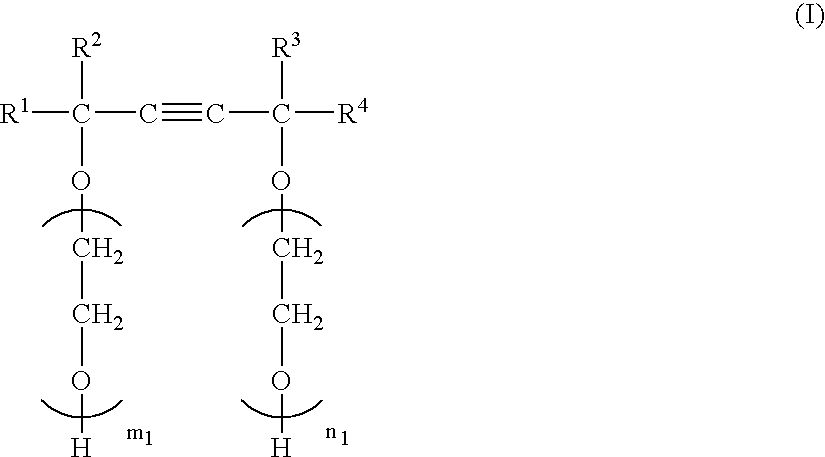Process for the preparation of pigment dispersion, pigment dispersion obtained by the same, ink jet recording ink comprising the same, and recording method and recorded material using the same
a technology of pigment dispersion and ink jet, which is applied in the field of preparation of pigment dispersion, can solve the problems of difficult to keep dispersed dispersant type pigment stably in an aqueous medium, difficult to keep dispersant type pigment in particulate form, and spontaneous sedimentation of pigment particles, etc., to achieve stable printing properties, high image quality, and high speed of operation
- Summary
- Abstract
- Description
- Claims
- Application Information
AI Technical Summary
Benefits of technology
Problems solved by technology
Method used
Image
Examples
synthesis example 1
(1) Synthesis of “Vinyl Polymer 1”
[0228]Into a reaction vessel equipped with an agitator, a reflux condenser, a dropping funnel, a thermometer and a nitrogen inlet pipe were charged 20 parts of methyl ethyl ketone as a polymerization solvent and 12 parts of tert-butyl methacrylate, 2 parts of polyethylene glycol methacrylate, 5 parts of acrylic acid, 1 part of a silicon macromer FM-0711 (trade name, produced by CHISSO CORPORATION) and 0.6 part of n-dodecyl mercaptan as polymerizable unsaturated monomers. The air within the reaction vessel was then thoroughly replaced by nitrogen gas. Separately, into the dropping funnel in which the air within had been thoroughly replaced by nitrogen gas were charged 48 parts of tert-butyl methacrylate, 8 parts of polyethylene glycol methacrylate, 20 parts of acrylic acid, 4 parts of a silicon macromer FM-0711 (trade name, produced by CHISSO CORPORATION), 2.4 parts of n-dodecyl mercaptan, 60 parts of methyl ethyl ketone, and 0.2 part of 2,2′-azobis(...
synthesis example 2
(1) Synthesis of “Vinyl Polymer 2”
[0234]Into a reaction vessel equipped with an agitator, a reflux condenser, a dropping funnel, a thermometer and a nitrogen inlet pipe were charged 20 parts of methyl ethyl ketone as a polymerization solvent and 6 parts of benzyl methacrylate, 2 parts of polyethylene glycol methacrylate, 5 parts of methacrylic acid, 7 parts of tert-octylacrylamide and 0.6 part of tert-dodecyl mercaptan as polymerizable unsaturated monomers. The air within the reaction vessel was then thoroughly replaced by nitrogen gas. Separately, into the dropping funnel in which the air within had been thoroughly replaced by nitrogen gas were charged 24 parts of benzyl methacrylate, 8 parts of polyethylene glycol methacrylate, 20 parts of methacrylic acid, 28 parts of tert-octylacrylamide, 2.4 parts of tert-dodecyl mercaptan, 60 parts of methyl ethyl ketone, and 0.2 part of 2,2′-azobis(2,4-dimethylvaleronitrile).
[0235]In a nitrogen atmosphere, the mixture in the reaction vessel w...
example 1
(1) Preparation of Surface-treated Pigment: Carbon Black
[0240](Surface Treatment Step)
[0241]15 parts of carbon black (“MA-7” produced by MITSUBISHI CHEMICAL CORPORATION) were mixed with 200 parts of sulfolane. The mixture was then subjected to dispersion with a percent bead packing of 70% at a rotary speed of 5,000 rpm by means of a Type M250 Eiger motor mill (produced by Eiger Japan K.K.) for 1 hour. The mixture of dispersed pigment paste and solvent was transferred into an evaporator where it was then heated to a temperature of 120° C. under a pressure of not higher than 30 mmHg to distill off water content contained in the system as much as possible. The temperature of the solution was then controlled to 150° C.
[0242]Subsequently, to the solution were added 25 parts of sulfur trioxide. The mixture was then allowed to undergo reaction for 6 hours. After the termination of the reaction, the reaction solution was washed with excessive sulfolane several times, poured into water, and ...
PUM
| Property | Measurement | Unit |
|---|---|---|
| Temperature | aaaaa | aaaaa |
| Fraction | aaaaa | aaaaa |
| Fraction | aaaaa | aaaaa |
Abstract
Description
Claims
Application Information
 Login to View More
Login to View More - R&D
- Intellectual Property
- Life Sciences
- Materials
- Tech Scout
- Unparalleled Data Quality
- Higher Quality Content
- 60% Fewer Hallucinations
Browse by: Latest US Patents, China's latest patents, Technical Efficacy Thesaurus, Application Domain, Technology Topic, Popular Technical Reports.
© 2025 PatSnap. All rights reserved.Legal|Privacy policy|Modern Slavery Act Transparency Statement|Sitemap|About US| Contact US: help@patsnap.com



